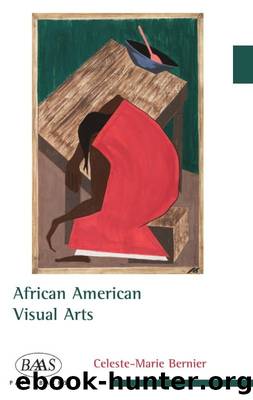African American Visual Arts (British Association for American Studies (BAAS) by Celeste-Marie Bernier

Author:Celeste-Marie Bernier [Bernier, Celeste-Marie]
Format: epub
Tags: editing
Published: 2008-10-07T08:12:25+00:00
The Contribution of the Negro to Democracy in America(1943, Plate 7)
The âpoint of my awareness of blacknessâ, Charles White admitted, was the âdiscovery of black historyâ (UCWP, White, âCharles Whiteâ, 1968: 57). As he explained, âI never knew Negroes wrote novels, that they wrote poetry, that they were outstanding leaders.â¯.â¯. I discovered Negro history.â¯.â¯. and man, it just blew my mind!â (Ibid.). For Charles White, â[n]o theme is more demanding of youâ, as a black artist, âthan that of Negro history and their great national figures. For the people must be able to relate to those meaningful qualities of personality, that while universal are sacred to the depth of national prideâ (CWP 3190, White, âMemoâ, 1956: 2). For this reason, he created numerous murals including: Five Great American Negroes (1939â40), A History of the Negro Press (1940), The Contribution of the Negro to Democracy in America (1943, see Plate 7) and Mary McLeod Bethune (1978). For White, the mural was the âstrongestâ medium he could find because it offered him the âroomâ to visualise the âbeautyâ, âdignityâ and âspiritualâ truth of the âinner-manâ (in Hoag, 1965: 13, 14). In these large-scale, full-colour and cubist inflected works, White represented important events and individuals from African American history. He encouraged black audiences to identify with his subjects by advocating a heroic continuum according to which the suffering of black families, workers, and activists were aggrandised in their juxtaposition with nineteenth-century historic and cultural leaders. These works were also inspired by his determination to oppose the denial of African American history in white mainstream culture. As a teenager, he had been furious to discover that the âbook that was the standard book at that time for U.S. history devoted only one line to the 400 years of black historyâ (UCWP, White, âCharles Whiteâ, 1968: 57).
White admitted that the creation of The Contribution of the Negro to Democracy in America was an âenormous jobâ (in Hoag, 1965: 11; see Plate 7). He executed the mural in egg tempera directly on to an interior wall of the music department at Hampton University, a historically black college, where it still stands. Standing in front of this mural a year ago, I realised just how much is lost in small-scale reproductions. They fail to capture the intricacies of Whiteâs black figures whose epic proportions reinforce their mythical status. White chose Hampton because he wanted to instil a sense of pride and heritage into African American university scholars. This town was also an apt location given that it was the place in which he had been forced to the back of a bus at gunpoint. For a painter who insisted his works were not satirical, it is difficult not to see an ironic subtext here. In general terms, the visual drama of this work derives from Whiteâs experimentation with an abstract composition, symbolism and symmetry. As such, this mural can be compared with Romare Beardenâs later photomontage projections. Both epic-size works generate interpretative ambiguity in their crowded spatial arrangements and experimental colour symbolism.
Download
This site does not store any files on its server. We only index and link to content provided by other sites. Please contact the content providers to delete copyright contents if any and email us, we'll remove relevant links or contents immediately.
The Japanese by Christopher Harding(1085)
Watercolor With Me in the Forest by Dana Fox(753)
A Theory of Narrative Drawing by Simon Grennan(742)
The Story of the Scrolls by The Story of the Scrolls; the M(725)
Glittering Images: A Journey Through Art From Egypt to Star Wars by Camille Paglia(717)
Boris Johnson by Tom Bower(620)
This Is Modern Art by Kevin Coval(597)
The Art and Science of Drawing by Brent Eviston(588)
Frida Kahlo by Frida Kahlo & Hayden Herrera(584)
AP Art History by John B. Nici(574)
Banksy by Will Ellsworth-Jones(569)
War Paint by Woodhead Lindy(551)
Van Gogh by Gregory White Smith(547)
Draw More Furries by Jared Hodges(544)
About Looking by John Berger(543)
Scenes From a Revolution by Mark Harris(542)
Ecstasy by Eisner.;(535)
100 Greatest Country Artists by Hal Leonard Corp(523)
Young Rembrandt: A Biography by Onno Blom(512)
